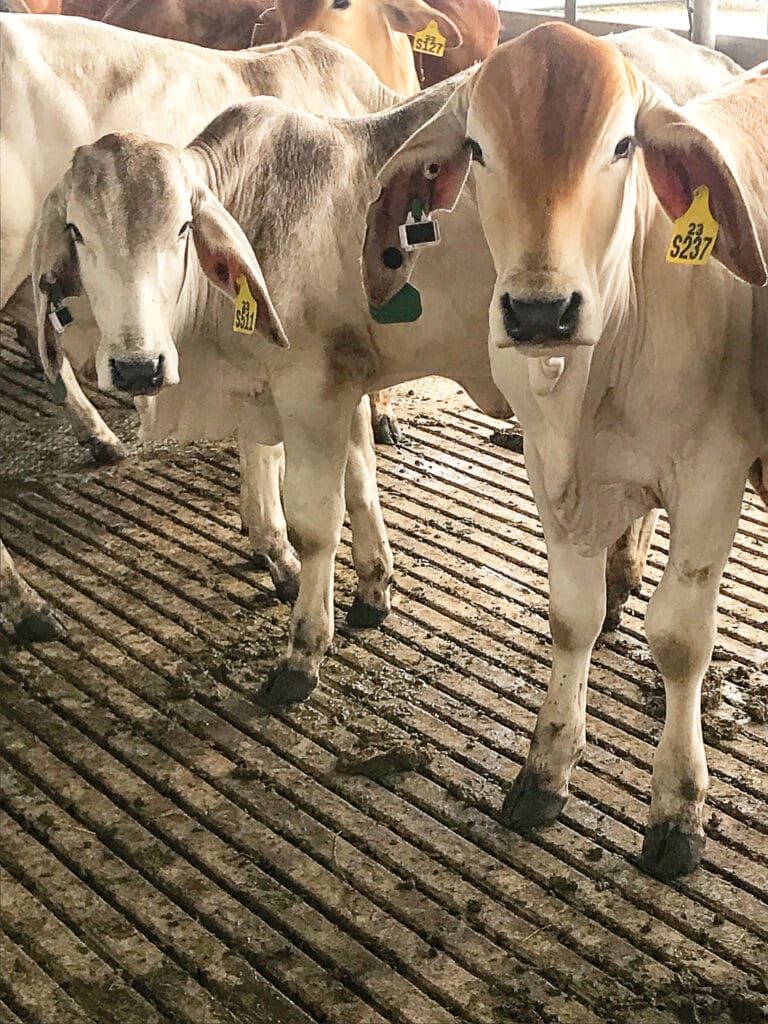A NEW phase of work has commenced in the Northern Breed Information Nucleus (BIN) genetics project based at Warraka station, near Taroom in Central Queensland, with the deployment of Ceres smart ear tags on 122 Spyglass station Brahman steers.
Ceres tags are equipped with accelerometer and GPS positioning technology and communicate with a series of low-level satellites to upload data on animal location, behaviour, and movement.
 Ceres has a license from CSIRO to use the eGrazor software technology which interprets the accelerometer data into animal behaviour characteristics, time grazing, resting, ruminating, walking, drinking and other actions.
Ceres has a license from CSIRO to use the eGrazor software technology which interprets the accelerometer data into animal behaviour characteristics, time grazing, resting, ruminating, walking, drinking and other actions.
Research conducted by CSIRO and NSW DPI has shown that dry matter intake can be predicted using the animal behaviour relationships.
Thirty of the No 23 (birth year) Brahman steers equipped with Ceres tags and 30 Droughtmaster steers, some with Ceres tags, have been transferred to University of Queensland, Gatton where they have also been fitted with CSIRO eGrazor collars.
Animal behaviour observations will be recorded, and refinements will be made to the eGrazor algorithms which characterise the animal behaviours. The refinements will then be applied across all the tags.
The tags will remain on the Spyglass steers until May 2024. Interim weights as well as a final weights will be taken and the data, along with daily animal behaviour profiles and estimated DMI data, will be analysed and feed efficiency values calculated.
The tags will be transferred to the Brahman and Santa Gertrudis Brian Pastures No 23 steers in May and additional daily animal behaviour and estimated DMI data will be collected. Starting, interim and final weights will also be collected.
The same process will then be followed with the Spyglass and Brian Pastures Brahman and Santa Gertrudis No 24 steers.
The Spyglass No 23 steers at UQ Gatton will spend four weeks grazing pastures wearing the eGrazor collars. In January they will commence a feedlot trial with Growsafe feeders which measure individual animal feed consumption also wearing eGrazor collars.
This is the second trial of this nature conducted at UQ. The first with the Spyglass No 22 steers, which finished early last year, showed that the feedlot feeding behaviour classification is different to grazing behaviour classification. This required major amendments to the eGrazor algorithm to accommodate a feedlot situation.
The Growsafe system is the industry standard for measuring feed intake and BreedPlan analysis of the feed efficiency Net Feed Intake trait. NFI values will also be calculated using Ceres tag DMI data and weight gain performance and corellated with Growsafe derived NFI values.
Methane measurements
In an allied project run by University of Queensland, Professor Ben Hayes, Greenfeed methane measurement units will also be used in the final phase of the Growsafe feeding trial to collect data on actual methane output.
This will be correlated with methane output data calculated from the Ceres tag DMI values. This is the second project involving Prof Hayes. The Greenfeed methane measurement data on the No 22 steers earlier last year showed a good correlation between improved feed efficiency and reduced methane output.
Because the project managers have a genomic sequence on all the trial animals, the aim is that when there is a sufficiently large number of records, a grazing feed efficiency genomic EBV can be produced.
Ceres tag and eGrazor DMI data is estimated based on animal behaviour profiles, rather than a direct measurement. On a herd population basis, much larger numbers of records can be collected at a lower cost which will improve the accuracy of the data for the sires and dams involved.
About the Northern BIN Project
The joint Northern BIN Steer Project involving the Australian Brahman Breeders’ Association, Droughtmasters Stud Breeders Society and a consortium of Santa Gertrudis breeders with funding assistance from the Meat & Livestock Australia Donor started in 2015 and is now in its tenth year.
The project purchases the steers from the Repronomics project from Spyglass and Brian Pastures research herds just after weaning and backgrounds them on industry properties.
The Northern BIN Steer Project is providing growth and carcase data which is assisting in the availability of genomically enhanced EBVs through the “Single Step” analysis and a future Tropical crossbred analysis. This is possible as the Brahman and Droughtmaster steers (from Spyglass and Brian Pastures) and Santa Gertrudis steers from Brian Pastures have been run together since birth, having only been split during the joining period of their dams in the Repronomics Project.
To date the Northern BIN Steer Project has purchased about 3500 steers, of which about 1600 are Brahmans, produced by more than 100 different sires.
The sires of the steers are either proven sires with a large number of registered progeny (few of which have been performance recorded with BreedPlan) or young up and coming bulls.
Data collected on the steers includes 400 day and 600 day weights, carcase scans at 600 day weight and prior to slaughter. Steers are also structurally scored at the scan prior to slaughter.
Meat Standards Australia data is collected in the meatworks chillers, and a meat sample is taken and sent the meat science lab at the University of New England, where shear force and intra-muscular fat data is collected.
Source: ABBA



HAVE YOUR SAY